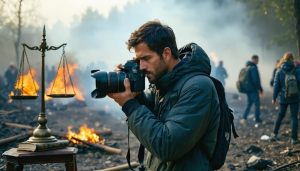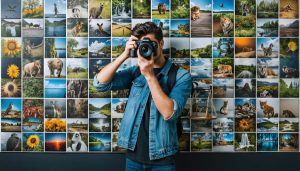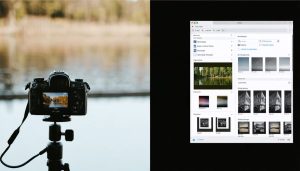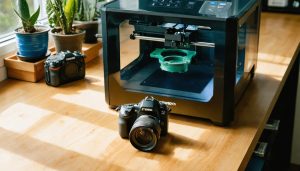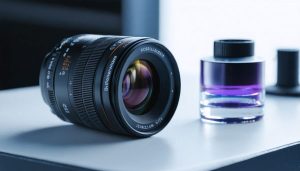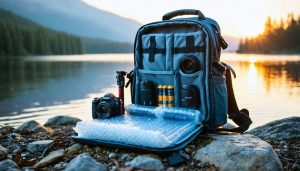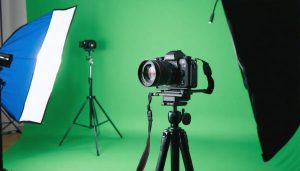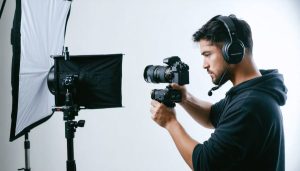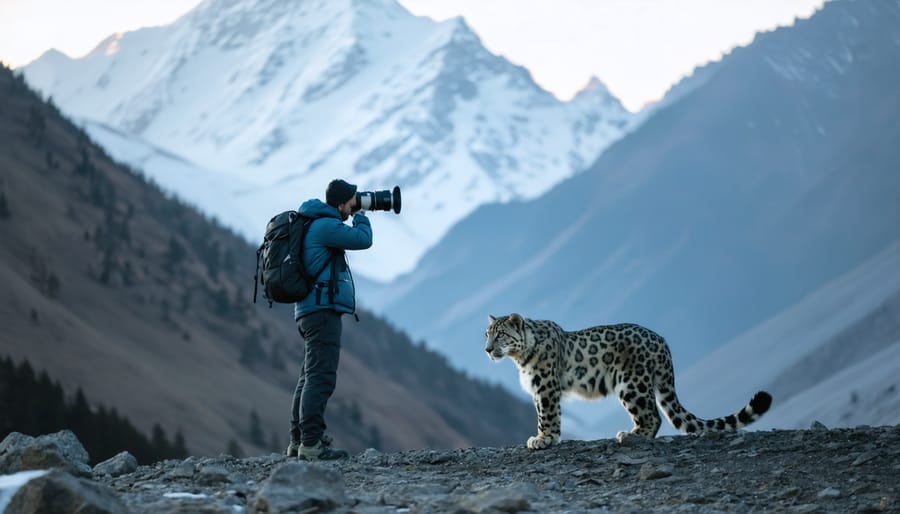
A snow leopard crouches in the Himalayan dawn, her breath visible in the frigid air. The camera shutter whispers, capturing both her raw power and vulnerability in a single frame. This delicate moment exemplifies the essence of wildlife photojournalism – where technical expertise meets wildlife photography ethics, creating visual stories that inspire conservation while respecting nature’s boundaries.
In an era where environmental storytelling has never been more crucial, wildlife photojournalists serve as both artists and advocates. Their images bridge the gap between distant ecosystems and global audiences, transforming complex environmental challenges into compelling visual narratives that demand attention and action. These photographers navigate treacherous terrain, extreme weather, and ethical dilemmas to document Earth’s incredible biodiversity – all while adhering to strict principles of non-interference and animal welfare.
Yet the craft extends far beyond merely capturing stunning images. Today’s wildlife photojournalists must master a complex blend of field craft, technological expertise, and storytelling ability. They must understand animal behavior, predict decisive moments, and maintain unwavering patience – often waiting days or weeks for a single, powerful shot that can change hearts and minds about wildlife conservation.
This exploration into wildlife photojournalism reveals not just how to capture remarkable images, but how to do so while serving as responsible stewards of the natural world. Whether documenting endangered species or revealing previously unknown animal behaviors, these visual storytellers help shape our understanding of – and commitment to – protecting Earth’s precious wildlife.
The Dual Role of Wildlife Photojournalists
Storyteller vs. Conservationist
Wildlife photojournalists often find themselves walking a delicate tightrope between two crucial responsibilities: telling compelling stories through their images and protecting the very subjects they photograph. This balance can create challenging ethical dilemmas in the field.
As storytellers, photographers feel pressure to capture dramatic moments that will engage viewers and raise awareness about wildlife issues. Sometimes, this might mean getting closer to animals or waiting longer for the perfect shot. However, these same actions could potentially stress animals or disrupt their natural behaviors.
Consider the case of photographing endangered species nesting sites. While documenting these locations could create powerful conservation messages, revealing their whereabouts might expose vulnerable populations to poachers or excessive tourism. Similarly, using camera flash or drone photography might get stunning results but could disturb wildlife’s natural patterns.
The solution lies in adopting a “conservation-first” mindset. Professional wildlife photojournalists increasingly embrace techniques that prioritize animal welfare over getting the perfect shot. This includes using longer lenses to maintain safe distances, learning about animal behavior to anticipate movements rather than pursuing them, and sometimes choosing not to take a photo if it might harm the subject.
The most successful wildlife photojournalists have learned that patience and respect for their subjects often result in more authentic and powerful images. By putting conservation first, they ultimately tell better stories that serve both journalism and wildlife preservation.
Impact on Public Awareness
Powerful wildlife photography has repeatedly proven its ability to spark global conservation movements and transform public perception of endangered species. When photographers capture compelling moments in nature, these images often become catalysts for change, turning abstract environmental concerns into visceral, emotional experiences for viewers.
Consider how photos of polar bears on melting ice caps have become symbols of climate change, making complex environmental issues instantly relatable. Through environmental photojournalism, photographers have successfully highlighted critical issues like deforestation, habitat loss, and species extinction, compelling viewers to care about and act on these challenges.
Social media has amplified this impact exponentially. A single striking image of a sea turtle entangled in plastic waste or an orphaned orangutan can reach millions within hours, sparking conversations and driving support for conservation initiatives. These photographs serve as powerful educational tools, helping the public understand complex ecological relationships and the consequences of human actions on wildlife.
The most effective wildlife photos don’t just document; they tell stories that connect viewers emotionally to their subjects. When people develop this emotional connection to wildlife through photography, they’re more likely to support conservation efforts, modify their behavior, and become advocates for environmental protection. This ripple effect demonstrates how ethical wildlife photography serves as a crucial bridge between nature and human consciousness.
Critical Ethical Guidelines in Wildlife Photography
Maintaining Natural Behavior
In wildlife photojournalism, one of the most critical principles for photojournalists is maintaining the natural behavior of their subjects. This means resisting the temptation to interfere with wildlife for the sake of getting a better shot. When animals behave naturally, without human influence, the resulting images tell authentic stories that serve both journalistic integrity and conservation efforts.
Successful wildlife photographers understand that patience is their greatest ally. Rather than baiting animals or disturbing their habitats, they spend hours or even days observing and waiting for natural moments to unfold. This might mean sitting quietly in a hide for countless hours or maintaining a respectful distance that allows animals to go about their daily routines undisturbed.
It’s crucial to recognize that staged or manipulated wildlife scenarios can mislead viewers and potentially harm conservation efforts by creating unrealistic expectations about animal behavior. For instance, photos of predators and prey in unusually close proximity might suggest peaceful coexistence where none exists in nature.
Consider using longer lenses and remote triggers to maintain distance from your subjects. Modern camera technology allows for incredible shots without requiring close physical proximity. Remember, the goal is to document wildlife as it truly exists, not as we wish it to be. This approach not only produces more authentic images but also helps protect the very subjects we aim to photograph.
Safe Distance and Equipment Choices
Maintaining a safe distance from wildlife isn’t just about ethics – it’s essential for both your safety and the animals’ well-being. The general rule of thumb is to stay far enough away that the animal’s behavior isn’t altered by your presence. This often means investing in quality telephoto lenses, typically in the 400mm to 600mm range, which allow you to capture intimate shots without intrusion.
For larger mammals, staying at least 25 meters away is recommended, while birds may require even greater distances to prevent disturbance. Your choice of equipment should reflect these requirements. A sturdy tripod is essential for sharp images with longer lenses, and a good teleconverter can extend your reach when needed.
Consider using a hide or blind when photographing particularly sensitive species. These temporary shelters help minimize your impact while allowing for close-up shots. Remote triggers and camera traps can also be valuable tools, especially for nocturnal animals or those that are particularly shy.
Weather-sealed equipment is worth the investment for wildlife photography, as you’ll often find yourself working in challenging conditions. Remember that the best shots often come from patience and preparation rather than trying to get closer. If an animal shows signs of stress – like stopping feeding or displaying defensive behavior – you’re too close and should slowly back away.
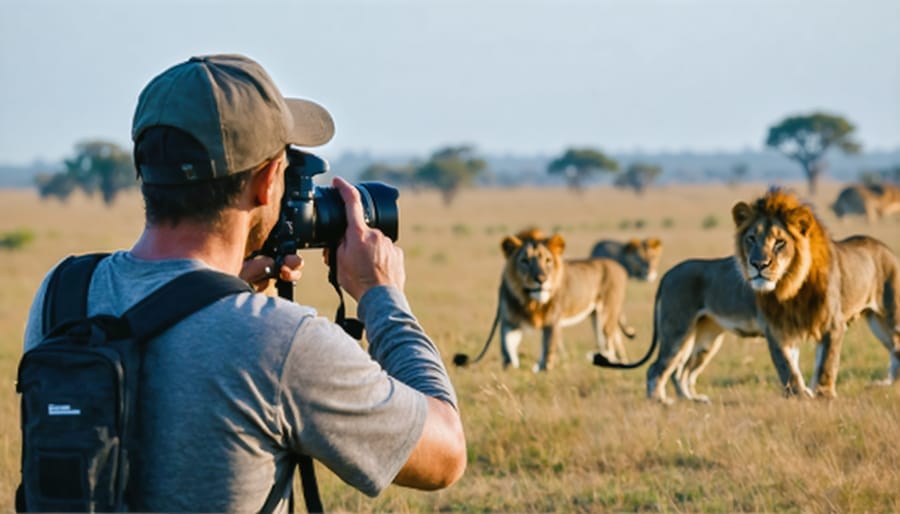
Habitat Protection
As wildlife photographers, our first responsibility is to protect the habitats we document. This means following protected area photography guidelines and adopting a “leave no trace” mindset wherever we shoot.
Start by staying on designated paths and avoiding trampling vegetation. Even seemingly resilient environments can take years to recover from damage. When photographing ground-dwelling species, use existing clearings rather than creating new ones. If you need to set up equipment, look for stable, bare ground that won’t be harmed by your tripod or gear.
Be especially mindful during breeding seasons when animals are most vulnerable. Maintain a safe distance from nests and dens, using longer lenses instead of getting physically closer. Remember that your presence can stress wildlife and potentially cause parents to abandon their young.
Consider timing your visits to minimize impact. Dawn and dusk not only offer beautiful light but often mean fewer people in the area. Research your locations in advance to understand seasonal sensitivities and local regulations. Some habitats may be completely off-limits during certain times of the year.
Pack out everything you bring in, including batteries, memory cards, and any trash you find. Better yet, participate in local conservation efforts. Many successful wildlife photographers partner with environmental organizations, using their images to support habitat preservation initiatives while building valuable relationships with local conservation communities.
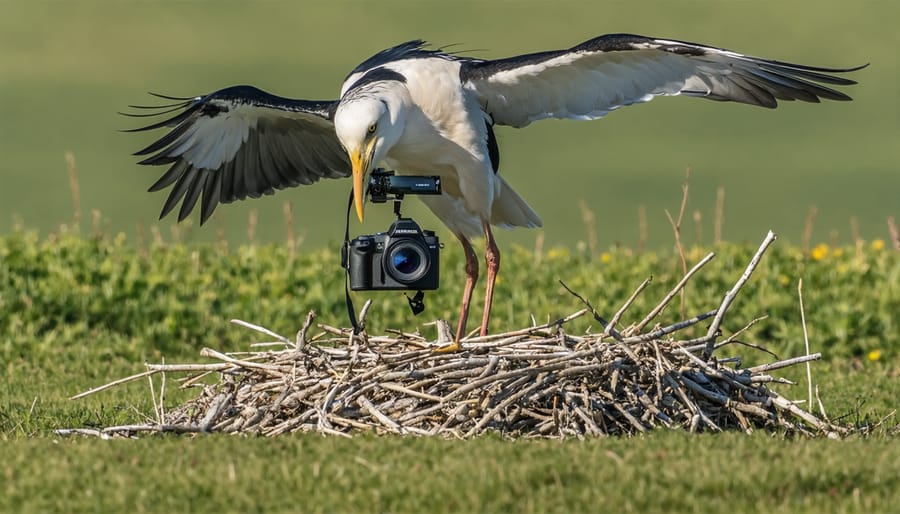
Digital Manipulation and Truth in Documentation
Acceptable vs. Deceptive Editing
While digital editing is an integral part of modern wildlife photography, understanding ethical boundaries in photography is crucial for maintaining authenticity. Acceptable editing practices include basic adjustments to exposure, contrast, and color balance to accurately represent what the photographer witnessed in the field. Minor cropping, dust spot removal, and subtle sharpening are also generally accepted, as they don’t alter the fundamental truth of the scene.
However, certain editing techniques cross into deceptive territory. Adding or removing animals, changing backgrounds, or dramatically altering natural colors misrepresents reality and violates photojournalistic principles. Composite images, while creative, should never be presented as genuine wildlife documentation. Similarly, excessive saturation or HDR effects that create unrealistic scenes can mislead viewers about natural animal behavior and habitats.
Professional wildlife photographers should maintain detailed records of their editing process and be transparent about any significant adjustments made to their images. Many publications and contests now require submission of RAW files alongside edited versions to verify authenticity. When in doubt, consider whether your edits serve to enhance the accurate representation of the scene or if they’re creating a false narrative. Remember, the goal is to document wildlife authentically, not to create fantasy images that might harm public understanding of natural ecosystems.
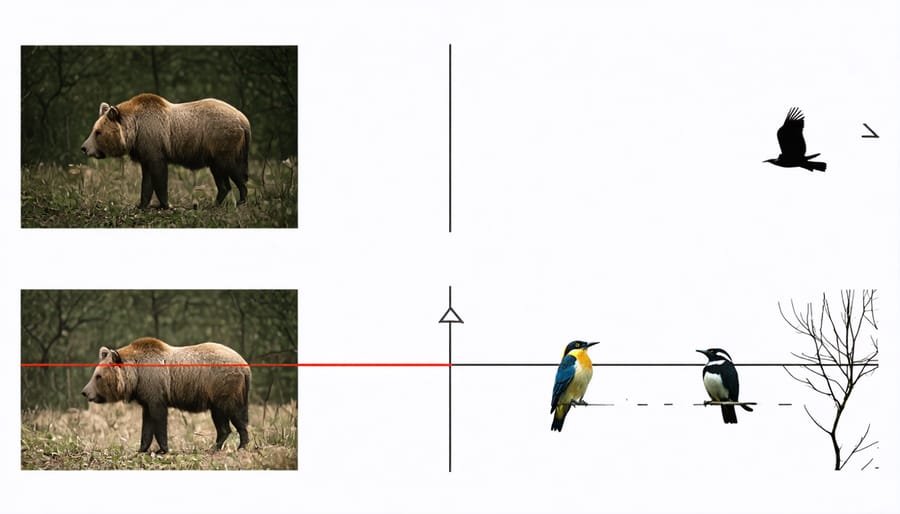
Caption Integrity
In wildlife photojournalism, the caption is as crucial as the image itself. Accurate, detailed captions provide essential context that transforms a beautiful photograph into a meaningful document of natural history. When photographers misrepresent the circumstances of an image – whether by claiming a captive animal is wild, fabricating behavior, or providing incorrect species information – they undermine the integrity of both journalism and conservation efforts.
Consider a photograph of a wolf howling at the moon. While it might be tempting to craft a romantic narrative, ethical photojournalists must stick to verifiable facts: the location, date, observed behavior, and relevant environmental conditions. If the wolf was photographed in a sanctuary rather than the wild, this must be clearly stated. Similarly, if digital manipulation was used to combine multiple elements, such as adding the moon from a separate image, this information should be disclosed.
Caption integrity also extends to scientific accuracy. Work with experts when needed to ensure correct species identification and behavior interpretation. Avoid anthropomorphizing animals by attributing human emotions or motivations to their actions. Instead, describe observable behaviors and let readers draw their own conclusions.
Remember that your captions may be used by researchers, educators, and other journalists. By maintaining high standards of caption integrity, you contribute to the collective understanding of wildlife behavior and support conservation efforts through accurate documentation.
Real-World Ethical Dilemmas
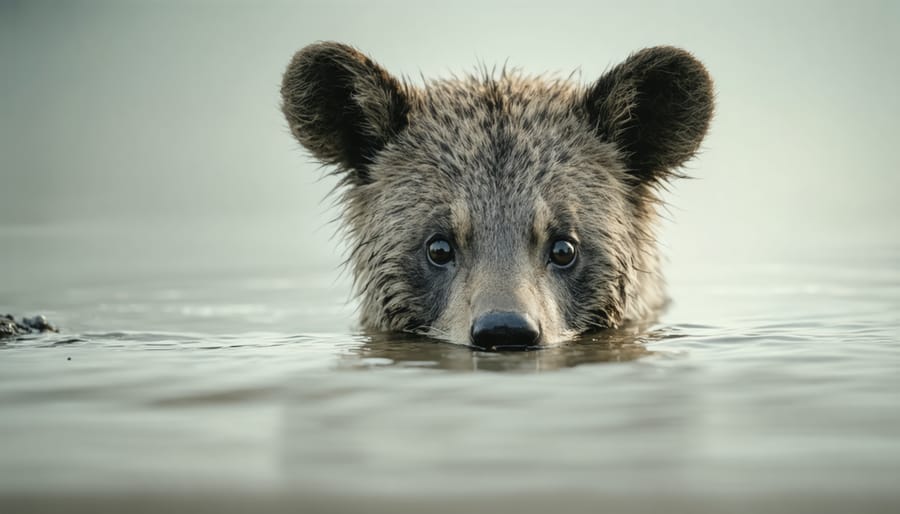
When to Intervene
The question of when to intervene while photographing wildlife is one of the most challenging ethical dilemmas photographers face in the field. While the general rule is to maintain a hands-off approach, there are specific situations where intervention might not only be appropriate but morally necessary.
If you encounter an animal that’s clearly injured or distressed due to human activity – such as being tangled in fishing line or trapped in plastic waste – alerting local wildlife authorities or licensed rescuers is appropriate. However, avoid attempting a rescue yourself unless you have proper training, as this could endanger both you and the animal.
Documentation of natural events, even difficult ones, is a crucial aspect of wildlife photojournalism. When witnessing natural predation or territorial disputes, it’s essential to let nature take its course. These moments, though potentially distressing, tell important stories about ecosystem dynamics and animal behavior.
There are, however, strict prohibitions against interfering with wildlife for the sake of a photograph. This includes:
– Baiting animals with food
– Removing or relocating animals
– Disrupting natural behaviors
– Destroying or altering habitat
– Getting too close and causing stress
Professional wildlife photographers often follow the “if your presence changes the behavior, you’re too close” principle. When photographing nesting birds or animals with young, maintain extra distance and use appropriate long lenses to avoid causing parents to abandon their offspring.
If you witness illegal activities like poaching or habitat destruction, document the scene safely and report it to authorities immediately. Your role as a photojournalist includes being a responsible witness to both natural events and human interference with wildlife.
Remember that your primary responsibility is to document, not direct. The best wildlife photographs come from patience and respect for natural behaviors, not from orchestrated scenarios or forced interactions.
Balancing Commercial Interests
Wildlife photojournalists often find themselves walking a delicate tightrope between capturing compelling images that sell and maintaining ethical standards that protect their subjects. The pressure to deliver dramatic shots that stand out in an increasingly competitive market can be intense, especially when publications and clients demand sensational imagery.
Consider the case of a sleeping bear cub – while approaching closer might yield a more intimate portrait, doing so could stress the animal or attract its protective mother. Smart photographers know that a slightly less dramatic but ethically captured image is always better than risking wildlife welfare for a shot. They rely instead on patience, proper telephoto equipment, and field craft to capture meaningful moments from safe distances.
Commercial success in wildlife photojournalism often comes from developing a signature style that doesn’t compromise ethics. Rather than baiting animals or disturbing habitats for more dramatic poses, successful photographers focus on unique perspectives, interesting behavior, and compelling storytelling through their images. They might spend days or weeks waiting for natural moments that tell powerful stories.
Publications are increasingly aware of ethical considerations too. Many now require photographers to disclose their methods and won’t accept images captured through questionable practices. This shift has helped create a market where ethical behavior is valued alongside artistic merit.
To balance commercial pressures effectively:
– Build relationships with ethical publications that value responsible photography
– Develop technical skills that allow capturing impact from a distance
– Document natural behavior rather than staged scenarios
– Be transparent about your methods with clients
– Create compelling narratives around conservation and natural behavior
– Focus on unique perspectives rather than dangerous proximity
Remember that a reputation for ethical practice can become a valuable commercial asset in itself, attracting clients who share these values and want their publications associated with responsible wildlife photography.
As wildlife photojournalists, we bear a profound responsibility that extends far beyond capturing compelling images. Our work serves as a vital bridge between the natural world and public consciousness, making our ethical practices paramount to both the credibility of our profession and the welfare of our subjects.
The choices we make in the field ripple outward, affecting not just individual animals but entire ecosystems and conservation efforts. When we prioritize ethical practices – maintaining safe distances, avoiding interference with natural behaviors, and being truthful in our documentation – we contribute to a broader culture of respect for wildlife and their habitats.
The impact of responsible wildlife photojournalism on conservation cannot be overstated. Our images have the power to inspire protection of endangered species, influence policy decisions, and educate the public about pressing environmental issues. Conversely, unethical practices can harm both wildlife and conservation efforts, potentially encouraging harmful behaviors in others who might seek to replicate staged or manipulated shots.
Looking ahead, the future of wildlife conservation is increasingly intertwined with how we choose to document and share nature’s stories. As technology advances and access to wildlife becomes easier, maintaining strict ethical standards becomes even more crucial. Every photograph we take should contribute positively to conservation efforts rather than potentially compromise them.
Remember that successful wildlife photojournalism isn’t measured solely by the dramatic impact of our images, but by how we obtain them. By embracing ethical practices, we ensure that our work serves its highest purpose: protecting and preserving the very subjects we photograph for generations to come.


